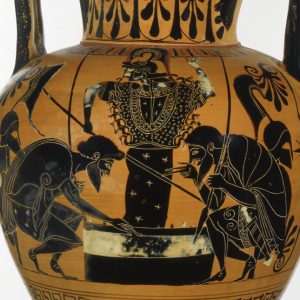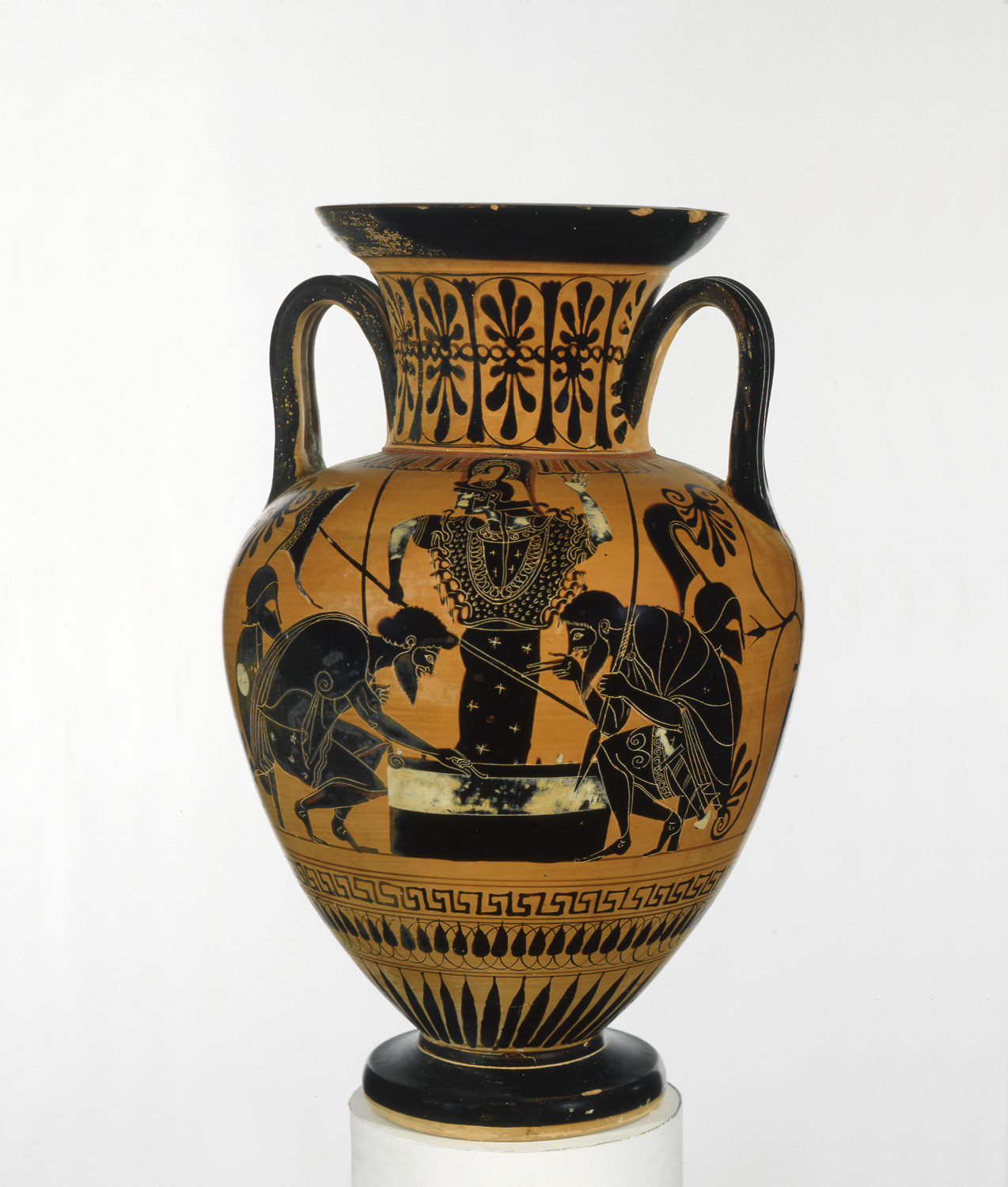
Lesson Concept: Greek Vase
Study the culture of ancient Greece and learn about its painted pottery!
Object Information
Black-Figure Neck Amphora
The ancient Greeks were masters of painted pottery. This vase was made in Attica, the area including and surrounding the city of Athens. Athenian pottery is known for its distinctive clay, which is rich in iron oxides that turn a deep red when fired. The vase is painted in the black-figure technique in which figures and decoration were painted with a slip (liquefied clay) that would turn black when the pot was fired in a kiln. The background, which initially retained the natural color of the clay, was then lightened by applying a weaker slip to those areas.
The shape seen here is an amphora (“carried on both sides”). They were used to transport liquids and solids such as wine, olive oil, grapes, and olives—natural resources that the Greeks traded throughout the Mediterranean world. Usually a potter made the vessel and a painter decorated it, although sometimes one person performed both tasks.
The scene on this amphora depicts two Greek warriors, Ajax and Achilles, taking a break from the action during the Trojan War to play a board game. Athena, goddess of war, stands over them. Athena appears extremely stiff and posed, which some believe is an indication that the figure is a statue. Although Achilles and Ajax are playing a game, they both seem ready to jump back into action at anytime: they are still holding their spears. The scene represented here is not found in the Iliad, but it became a popular subject for vase painters. It is not known exactly what game they are playing; it could be one similar to chess or a game involving dice. Scenes with gods, goddesses, and heroes were extremely popular subjects for Greek vase paintings.
Activities: Myth Writing and Amphora Decoration
ACTIVITY 1
Have the students write or read a story or myth about a Greek god or goddess. For a writing extension, they can also create a new myth or retell one they have heard before
ACTIVITY 2
Print out copies of the Ancient Greek Pottery Take & Make. Students can decorate the vase with a scene from the myth they read or wrote.
ACTIVITY 3
Students may also want to decorate with Greek motifs and figures they have studied, such as grapes and olives or athletes, gods, and goddesses. They can even add architectural details, such as columns and pediments.
Encourage the students to share their ideas about their amphorae and the details they have chosen!
Standards of Learning
Visual Arts: K.1, K.2, K.3, K.4, K.7, K.8, K.11, K.12, K.13, K.14, K.15, K.16, 1.1, 1.2, 1.3, 1.4, 1.5, 1.6, 1.7, 1.12, 1.13, 1.17, 1.20, 2.3,, 2.4, 2.5, 2.11, 2.13, 2.21, 3.2, 3.4, 3.5, 3.13, 3.16, 3.17, 3.19, 4.1, 4.3, 4.4, 4.5, 4.7, 4.8, 4.12, 4.18, 5.1, 5.3, 5.5, 5.9, 5.24
English: K.1 a, K.2 b–g, K.3 a–f, K.8 a–d, K-11, 1.1, 1.2 a–e, 1.3 a–d, 1.8, 1.9, 1.11, 1.12, 2.1, 2.2, 2.3, 2.5, 2.7, 2.8, 2.11, 2.12, 3.1, 3.2, 3.4, 3.5, 3.9, 3.10, 3.11, 4.1 b,e, 4.2, 4.4, 4.7, 4.8, 5.1, 5.2, 5.3, 5.4, 5.5, 5.8, 5.9
History: K.3, K.4 b, K.4 c, 1.4 b, 1.4 d, 1.6, 1.7, 1.8, 2.7, 2.8, 2.9, 3.1, 3.4, 3.6, 3.7, 3.8
Math: 1.17

